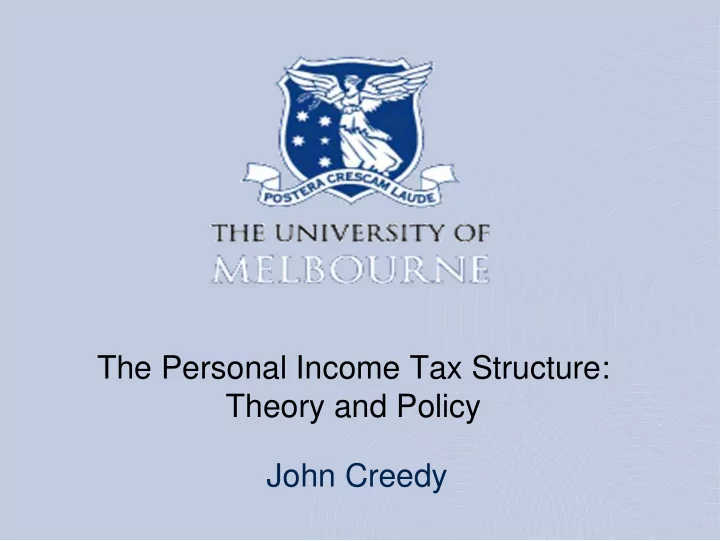

The Personal Income Tax Structure: Theory and Policy John Creedy
• Review lessons from theory • - Largely negative – But it is important to understand relationships involved and reasons why unequivocal policy advice cannot be given • Need for range of empirical analyses • Provide illustrations, using simple simulation models, of types of analysis
Classical Economists – List of Criteria • Adam Smith’s Maxims • ability to pay; certainty; convenience; efficiency (including admin costs, distortions to activity, and ‘vexation and oppression‘) • Lord Overstone • Productive; computable; divisible; frugal; non-interferent; unannoyant; equal; popular; uncorruptive. • In considering structure of direct taxation • – no transfer payments; tax rate very low; tax-free threshold • much debate turned on issue of ‘permanent’ versus ‘temporary’ incomes.
• No role for redistribution - proportionality • McCulloch • The moment you abandon the cardinal principle of exacting from all individuals the same proportion of their income or of their property, you are at sea without rudder or compass, and there is no amount of injustice and folly you may not commit.
Neoclassical Economists - Public Finance and Welfare Economics • Exploration of equal sacrifice in terms of utilitarianism • Cohen-Stuart and Edgeworth (fixed incomes): equal marginal sacrifice • Optimal Tax Theory – from 1970s • Mirrlees et al. - endogenous incomes • ‘Second best’ welfare economics
Optimal Tax Models and Policy Implications • Simplicity of Framework – complexity of analysis • Static, partial equilibrium • Tax structure: • Preferences: non-transfer expenditure does not affect individual behaviour (education, health, public goods) • Population heterogeneity • Evaluation: The ‘social welfare function’ • - Welfarist and non-welfarist approaches
Approach to Policy Advice • Variety of partial analyses, using a range of models and summary measures • Behavioural microsimulation modelling: captures full extent of population heterogeneity and complexity of T-T system • - Marginal income tax reform • - Progressivity and redistribution • - Welfare effects
Marginal Income Tax Reform • Considers optimal direction of small changes to existing structure • For each tax rate and threshold, can calculate the change in net tax revenue, R, and change in evaluation function, W. • Compare ratios of change in W to change in R (which would be equal in optimal system)
Piecewise-linear budget constraints Net Income C B Slope= net wage=w(1-t) Virtual Can be constructed given income only list of marginal tax rates and income thresholds, with A initial virtual income Hours Worked Hours threshold
Set of income thresholds and marginal rates Evaluation function:
Reduction in each rate by 0.02
Use of range of progressivity and inequality measures • Example: how are these affected by the introduction of a top marginal income tax rate? • Tax structure cannot be judged independently of the income distribution
Consider income tax only
Measures of welfare change, excess burden and marginal welfare cost … • These can vary substantially for nonlinear tax and transfer system • Often argued that excess burdens are small for high income-earners, who have low labour supply elasticity
Singles: Introduction of a top income tax rate Marginal excess burden = 10.84 Marginal welfare cost = 10.84/9.14 = 1.19
Conclusions • It is important to understand basic relationships involved in tax modelling • Policy advice requires empirical orders of magnitude relating to a range of summary measures, for range of individual and household types • Requires investment in construction and maintenance of applied models
Recommend
More recommend